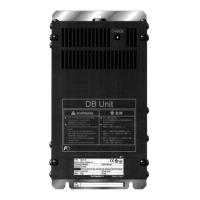4.6.3 V/f control with slip compensation active for IM
Applying any load to an induction motor causes a rotational slip due to the motor characteristics, decreasing the
motor rotation. The inverter’s slip compensation function first presumes the slip value of the motor based on the
motor torque generated and raises the output frequency to compensate for the decrease in motor rotation. This
prevents the motor from decreasing the rotation due to the slip.
That is, this function is effective for improving the motor speed control accuracy.
The compensation value is specified by combination of function codes P12
*
(Rated slip frequency), P09
*
(Slip
compensation gain for driving) and P11
*
(Slip compensation gain for braking).
H68
*
enables or disables the slip compensation function according to the motor driving conditions.
H68* data
Motor driving conditions Motor driving frequency zone
Accl/Decel Constant speed
Base frequency or
below
Above the base
frequency
0 Enable Enable Enable Enable
1 Disable Enable Enable Enable
2 Enable Enable Enable Disable
3 Disable Enable Enable Disable
4.6.4 V/f Control with speed sensor for IM
This control requires an optional PG (pulse generator) and an optional PG interface card to be mounted on a motor
shaft and on the inverter, respectively. Applying any load to an induction motor causes a rotational slip due to the
motor characteristics, decreasing the motor rotation.
Under V/f control with speed sensor, the inverter detects the motor rotation using the encoder mounted on the motor
shaft and compensates for the decrease in slip frequency by the PI control to match the motor rotation with the
commanded speed. This improves the motor speed control accuracy.
4.6.5 V/f Control with speed sensor with Auto Torque Boost for IM
The difference from the "V/f control with speed sensor" stated above is that this method calculates the motor torque
for the load applied and uses the calculated torque to optimize the output voltage and current vectors for getting the
maximal torque out of a motor.
This control is effective for improving the system response to external disturbances such as load fluctuations, and
for improving the motor speed control accuracy.
4.6.6 Vector Control with speed sensor for IM
This control requires an optional PG (pulse generator) and an optional PG interface card to be mounted on a motor
shaft and on the inverter, respectively. The inverter detects the motor's rotational position and speed from PG
feedback signals and uses them in the control. In addition, it decomposes the motor drive current into the exciting
and torque current components, and controls each of components in vector.
The desired response can be obtained by adjusting the control constants (PI constants) and using the speed
regulator (PI controller). This control enables the speed control with higher accuracy and quicker response than the
vector control without speed sensor.

